Temporal Empirical Dynamic Modeling
Last
update: 2025-09-05
Last run: 2025-11-07
Source: Last run: 2025-11-07
vignettes/tEDM.Rmd
tEDM.Rmd1. Introduction to the tEDM package
The tEDM package provides a suite of tools for exploring
and quantifying causality in time series using Empirical Dynamic
Modeling (EDM). It implements four fundamental EDM-based causal
discovery methods:
These methods enable researchers to:
Identify potential causal interactions without assuming a predefined model structure.
Distinguish between direct causation and indirect (mediated or confounded) influences.
Reconstruct underlying causal dynamics from replicated univariate time series observed across multiple spatial units.
2. Example data in the tEDM package
Hong Kong Air Pollution and Cardiovascular Admissions
A daily time series dataset(from 1995-3 to 1997-11) for Hong Kong that includes cardiovascular hospital admissions and major air pollutant concentrations.
File: cvd.csv
Columns:
| Column | Description |
|---|---|
cvd |
Daily number of cardiovascular-related hospital admissions. |
rsp |
Respirable suspended particulates (μg/m³). |
no2 |
Nitrogen dioxide concentration (μg/m³). |
so2 |
Sulfur dioxide concentration (μg/m³). |
o3 |
Ozone concentration (μg/m³). |
Source: Data adapted from PCM article.
US County-Level Carbon Emissions Dataset
A panel dataset covering U.S. county-level temperature and carbon emissions across time.
File: carbon.csv.gz
Columns:
| Column | Description |
|---|---|
year |
Observation year (1981–2017). |
fips |
County FIPS code (5-digit Federal Information Processing Standard code). |
tem |
Mean annual temperature (in Kelvin). |
carbon |
Total carbon emissions per year (in kilograms of CO₂). |
Source: Data adapted from FsATE article.
COVID-19 Infection Counts in Japan
A spatio-temporal dataset capturing the number of confirmed COVID-19 infections across Japan’s 47 prefectures over time.
File: covid.csv
Structure:
- Each column represents one of the 47 Japanese
prefectures (e.g.,
Tokyo,Osaka,Hokkaido). - Each row corresponds to a time step (daily).
Source: Data adapted from CMC article.
3. Case studies of the tEDM package
Install the stable version:
install.packages("tEDM", dep = TRUE)or dev version:
install.packages("tEDM",
repos = c("https://stscl.r-universe.dev",
"https://cloud.r-project.org"),
dep = TRUE)Air Pollution and Cardiovascular Health in Hong Kong
Employing PCM to investigate the causal relationships between various air pollutants and cardiovascular diseases:
library(tEDM)
cvd = readr::read_csv(system.file("case/cvd.csv",package = "tEDM"))
## Rows: 1032 Columns: 5
## ── Column specification ─────────────────────────────────────────────────────────
## Delimiter: ","
## dbl (5): cvd, rsp, no2, so2, o3
##
## ℹ Use `spec()` to retrieve the full column specification for this data.
## ℹ Specify the column types or set `show_col_types = FALSE` to quiet this message.
head(cvd)
## # A tibble: 6 × 5
## cvd rsp no2 so2 o3
## <dbl> <dbl> <dbl> <dbl> <dbl>
## 1 214 73.7 74.5 19.1 17.4
## 2 203 77.6 80.9 18.8 39.4
## 3 202 64.8 67.1 13.8 56.4
## 4 182 68.8 74.7 30.8 5.6
## 5 181 49.4 62.3 23.1 3.6
## 6 129 67.4 63.6 17.4 6.73
cvd_long = cvd |>
tibble::rowid_to_column("id") |>
tidyr::pivot_longer(cols = -id,
names_to = "variable", values_to = "value")
fig_cvds_ts = ggplot2::ggplot(cvd_long, ggplot2::aes(x = id, y = value, color = variable)) +
ggplot2::geom_line(linewidth = 0.5) +
ggplot2::labs(x = "Days (from 1995-3 to 1997-11)", y = "Concentrations or \nNO. of CVD admissions", color = "") +
ggplot2::theme_bw() +
ggplot2::theme(legend.direction = "horizontal",
legend.position = "inside",
legend.justification = c("center","top"),
legend.background = ggplot2::element_rect(fill = "transparent", color = NA))
fig_cvds_ts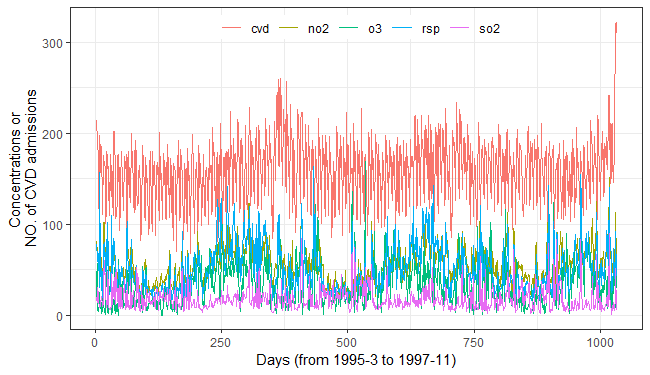
Determining optimal embedding dimension:
tEDM::fnn(cvd,"cvd",E = 2:50,eps = stats::sd(cvd$cvd))
## E:1 E:2 E:3 E:4 E:5 E:6 E:7 E:8
## 0.8275862 0.4882729 0.3026188 0.2880698 0.2133851 0.2065955 0.1920466 0.1871969
## E:9 E:10 E:11 E:12 E:13 E:14 E:15 E:16
## 0.1842871 0.1862270 0.1794374 0.1823472 0.1765276 0.1687682 0.1619787 0.1619787
## E:17 E:18 E:19 E:20 E:21 E:22 E:23 E:24
## 0.1503395 0.1483996 0.1629486 0.1513094 0.1542192 0.1658584 0.1610087 0.1610087
## E:25 E:26 E:27 E:28 E:29 E:30 E:31 E:32
## 0.1619787 0.1833172 0.1610087 0.1697381 0.1668283 0.1755577 0.1668283 0.1755577
## E:33 E:34 E:35 E:36 E:37 E:38 E:39 E:40
## 0.1648885 0.1668283 0.1668283 0.1580989 0.1464597 0.1571290 0.1590689 0.1639185
## E:41 E:42 E:43 E:44 E:45 E:46 E:47 E:48
## 0.1580989 0.1580989 0.1590689 0.1610087 0.1542192 0.1590689 0.1707081 0.1736178
## E:49
## 0.1677983Starting at \(E = 11\), the FNN ratio stabilizes near 0.18; thus, embedding dimension E and neighbor number k are chosen from 11 onward for subsequent self-prediction parameter selection.
tEDM::simplex(cvd,"cvd","cvd",E = 11:25,k = 12:26)
## The suggested E and k for variable cvd is 11 and 12
tEDM::simplex(cvd,"rsp","rsp",E = 11:25,k = 12:26)
## The suggested E and k for variable rsp is 11 and 12
tEDM::simplex(cvd,"no2","no2",E = 11:25,k = 12:26)
## The suggested E and k for variable no2 is 11 and 12
tEDM::simplex(cvd,"so2","so2",E = 11:25,k = 12:26)
## The suggested E and k for variable so2 is 11 and 16
tEDM::simplex(cvd,"o3","o3",E = 11:25,k = 12:26)
## The suggested E and k for variable o3 is 11 and 13
s1 = tEDM::simplex(cvd,"cvd","cvd",E = 11,k = 12:26)
s2 = tEDM::simplex(cvd,"rsp","rsp",E = 11,k = 12:26)
s3 = tEDM::simplex(cvd,"no2","no2",E = 11,k = 12:26)
s4 = tEDM::simplex(cvd,"so2","so2",E = 11,k = 12:26)
s5 = tEDM::simplex(cvd,"o3","o3",E = 11,k = 12:26)
list(s1,s2,s3,s4,s5)
## [[1]]
## The suggested E and k for variable cvd is 11 and 12
##
## [[2]]
## The suggested E and k for variable rsp is 11 and 12
##
## [[3]]
## The suggested E and k for variable no2 is 11 and 12
##
## [[4]]
## The suggested E and k for variable so2 is 11 and 16
##
## [[5]]
## The suggested E and k for variable o3 is 11 and 13
simplex_df = purrr::map2_dfr(list(s1,s2,s3,s4,s5),
c("cvd","rsp","no2","so2","o3"),
\(.list,.name) dplyr::mutate(.list$xmap,variable = .name))
ggplot2::ggplot(data = simplex_df) +
ggplot2::geom_line(ggplot2::aes(x = k, y = rho, color = variable))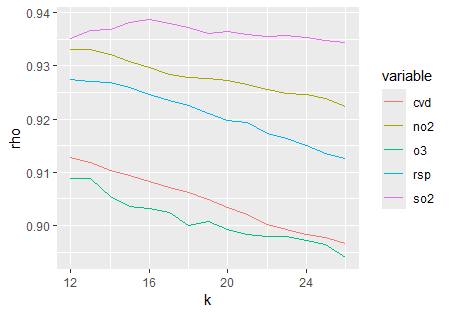
To investigate the causal influences of air pollutants on the incidence of cardiovascular diseases, we performed PCM analysis using an embedding dimension of 11 and 12 nearest neighbors per variable pair.
vars = c("cvd", "rsp", "no2", "so2", "o3")
res = list()
var_pairs = combn(vars, 2, simplify = FALSE)
for (pair in var_pairs) {
var1 = pair[1]
var2 = pair[2]
conds = setdiff(vars, pair)
key = paste0(var1, "_", var2)
res[[key]] = tEDM::pcm(data = cvd,
cause = var2,
effect = var1,
conds = conds,
libsizes = seq(12, 1012, 100),
E = 11, k = 12,
progress = FALSE)
}The PCM results are shown in the figure below:
fig_cvd_rsp = plot(res[["cvd_rsp"]], partial = FALSE,
xlimits = c(0,1030), ylimits = c(-0.01,0.2),
ybreaks = seq(0,0.2,by = 0.05),
legend_texts = c("CVD xmap RSP, P = 0",
"RSP xmap CVD, P = 0.001"))
fig_cvd_rsp_p = plot(res[["cvd_rsp"]], xlimits = c(0,1030),
ylimits = c(-0.01,0.2), ybreaks = seq(0,0.2,by = 0.05),
legend_texts = c("CVD xmap RSP | NO2 & SO2 & O3, P = 0",
"RSP xmap CVD | NO2 & SO2 & O3, P = 0.0179"))
fig_cvd_no2 = plot(res[["cvd_no2"]], partial = FALSE,
xlimits = c(0,1030), ylimits = c(0,0.35),
ybreaks = seq(0,0.35,by = 0.05),
legend_texts = c("CVD xmap NO2, P = 0",
"NO2 xmap CVD, P = 0"))
fig_cvd_no2_p = plot(res[["cvd_no2"]], xlimits = c(0,1030),
ylimits = c(0,0.35), ybreaks = seq(0,0.35,by = 0.05),
legend_texts = c("CVD xmap NO2 | RSP & SO2 & O3, P = 0",
"NO2 xmap CVD | RSP & SO2 & O3, P = 0"))
fig_cvd_so2 = plot(res[["cvd_so2"]], partial = FALSE,
xlimits = c(0,1030), ylimits = c(0,0.25),
ybreaks = seq(0,0.25,by = 0.05),
legend_texts = c("CVD xmap SO2, P = 0",
"SO2 xmap CVD, P = 0"))
fig_cvd_so2_p = plot(res[["cvd_so2"]], xlimits = c(0,1030),
ylimits = c(0,0.25), ybreaks = seq(0,0.25,by = 0.05),
legend_texts = c("CVD xmap SO2 | RSP & NO2 & O3, P = 0",
"SO2 xmap CVD | RSP & NO2 & O3, P = 0.003"))
fig_cvd_o3 = plot(res[["cvd_o3"]], partial = FALSE,
xlimits = c(0,1030), ylimits = c(-0.05,0.35),
ybreaks = seq(-0.05,0.35,by = 0.1),
legend_texts = c("CVD xmap O3, P = 0.495",
"O3 xmap CVD, P = 0.002"))
fig_cvd_o3_p = plot(res[["cvd_o3"]], xlimits = c(0,1030),
ylimits = c(-0.05,0.35), ybreaks = seq(-0.05,0.35,by = 0.1),
legend_texts = c("CVD xmap O3 | RSP & NO2 & SO2, P = 0.402",
"O3 xmap CVD | RSP & NO2 & SO2, P = 0.028"))
fig_rsp_no2 = plot(res[["rsp_no2"]], partial = FALSE,
xlimits = c(0,1030), ylimits = c(0.2,0.9),
ybreaks = seq(0.2,0.9,by = 0.1),
legend_texts = c("RSP xmap NO2, P = 0",
"NO2 xmap RSP, P = 0"))
fig_rsp_no2_p = plot(res[["rsp_no2"]], xlimits = c(0,1030),
ylimits = c(0.2,0.9), ybreaks = seq(0.2,0.9,by = 0.1),
legend_texts = c("RSP xmap NO2 | CVD & SO2 & O3, P = 0",
"NO2 xmap RSP | CVD & SO2 & O3, P = 0"))
fig_rsp_so2 = plot(res[["rsp_so2"]], partial = FALSE,
xlimits = c(0,1030), ylimits = c(0.05,0.55),
ybreaks = seq(0.05,0.55,by = 0.1),
legend_texts = c("RSP xmap SO2, P = 0",
"SO2 xmap RSP, P = 0"))
fig_rsp_so2_p = plot(res[["rsp_so2"]], xlimits = c(0,1030),
ylimits = c(0.05,0.55), ybreaks = seq(0.05,0.55,by = 0.1),
legend_texts = c("RSP xmap SO2 | CVD & NO2 & O3, P = 0",
"SO2 xmap RSP | CVD & NO2 & O3, P = 0"))
fig_rsp_o3 = plot(res[["rsp_o3"]], partial = FALSE,
xlimits = c(0,1030), ylimits = c(0.05,0.65),
ybreaks = seq(0.05,0.65,by = 0.1),
legend_texts = c("RSP xmap O3, P = 0",
"O3 xmap RSP, P = 0"))
fig_rsp_o3_p = plot(res[["rsp_o3"]], xlimits = c(0,1030),
ylimits = c(0.05,0.65), ybreaks = seq(0.05,0.65,by = 0.1),
legend_texts = c("RSP xmap O3 | CVD & SO2 & NO2, P = 0",
"O3 xmap RSP | CVD & SO2 & NO2, P = 0"))
fig_no2_so2 = plot(res[["no2_so2"]], partial = FALSE,
xlimits = c(0,1030), ylimits = c(0.15,0.75),
ybreaks = seq(0.15,0.75,by = 0.1),
legend_texts = c("NO2 xmap SO2, P = 0",
"SO2 xmap NO2, P = 0"))
fig_no2_so2_p = plot(res[["no2_so2"]], xlimits = c(0,1030),
ylimits = c(0.15,0.75), ybreaks = seq(0.15,0.75,by = 0.1),
legend_texts = c("NO2 xmap SO2 | CVD & RSP & O3, P = 0",
"SO2 xmap NO2 | CVD & RSP & O3, P = 0"))
fig_no2_o3 = plot(res[["no2_o3"]], partial = FALSE,
xlimits = c(0,1030), ylimits = c(0.05,0.65),
ybreaks = seq(0.05,0.65,by = 0.1),
legend_texts = c("NO2 xmap O3, P = 0",
"O3 xmap NO2, P = 0"))
fig_no2_o3_p = plot(res[["no2_o3"]], xlimits = c(0,1030),
ylimits = c(0.05,0.65), ybreaks = seq(0.05,0.65,by = 0.1),
legend_texts = c("NO2 xmap O3 | CVD & RSP & SO2, P = 0",
"O3 xmap NO2 | CVD & RSP & SO2, P = 0"))
fig_so2_o3 = plot(res[["so2_o3"]], partial = FALSE,
xlimits = c(0,1030), ylimits = c(-0.05,0.45),
ybreaks = seq(-0.05,0.45,by = 0.1),
legend_texts = c("SO2 xmap O3, P = 0",
"O3 xmap SO2, P = 0.094"))
fig_so2_o3_p = plot(res[["so2_o3"]], xlimits = c(0,1030),
ylimits = c(-0.05,0.45), ybreaks = seq(-0.05,0.45,by = 0.1),
legend_texts = c("SO2 xmap O3 | CVD & RSP & NO2, P = 0",
"O3 xmap SO2 | CVD & RSP & NO2, P = 0.131"))
fig_pcm = cowplot::plot_grid(fig_cvd_rsp, fig_cvd_rsp_p, fig_cvd_no2, fig_cvd_no2_p,
fig_cvd_so2, fig_cvd_so2_p, fig_cvd_o3, fig_cvd_o3_p,
fig_rsp_no2, fig_rsp_no2_p, fig_rsp_so2, fig_rsp_so2_p,
fig_rsp_o3, fig_rsp_o3_p, fig_no2_so2, fig_no2_so2_p,
fig_no2_o3, fig_no2_o3_p, fig_so2_o3, fig_so2_o3_p,
ncol = 4, label_fontfamily = 'serif',
labels = letters[1:20],
label_x = -0.005, label_y = 1)
fig_pcm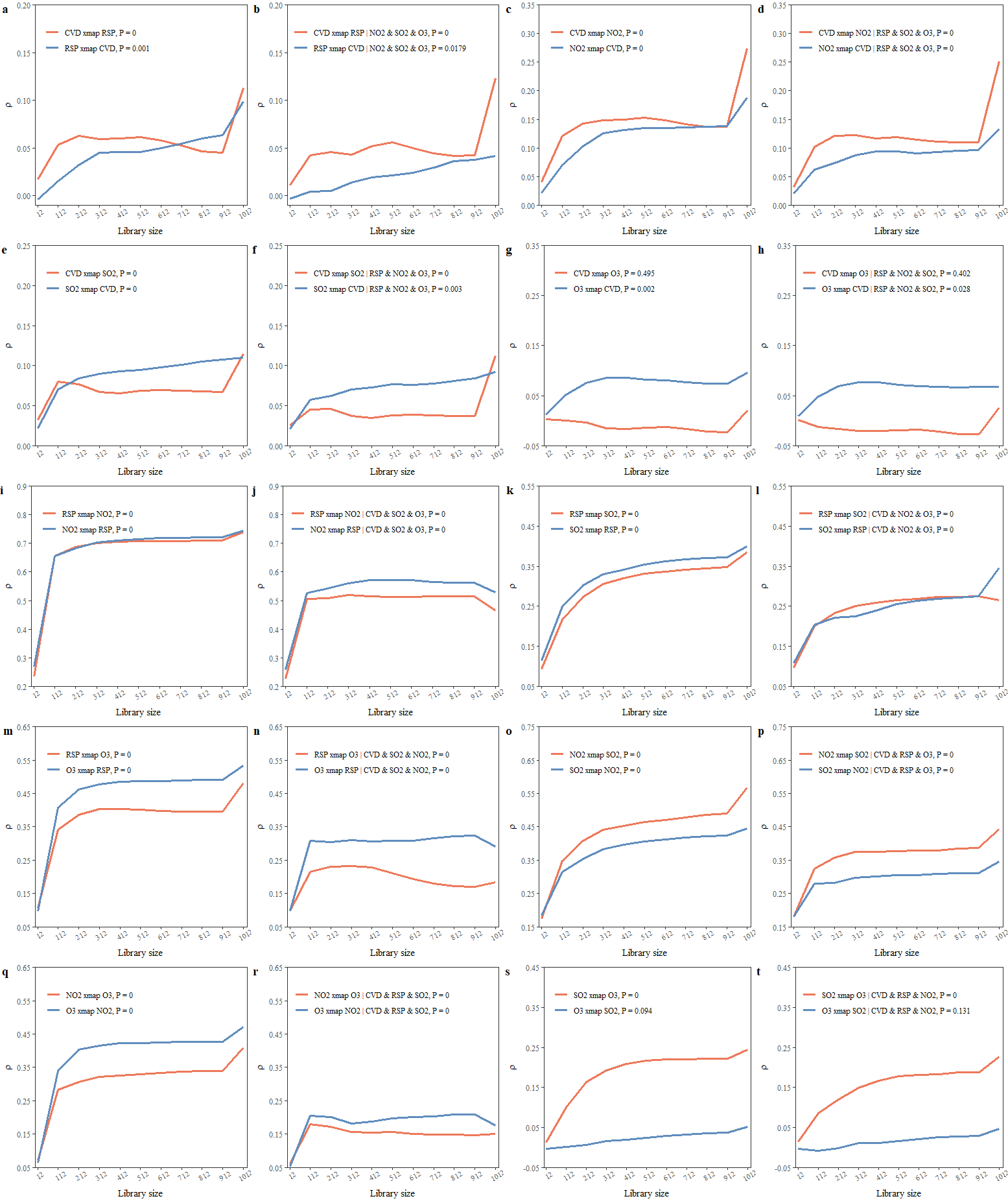
From Figure 3, we can infer the following causal links:
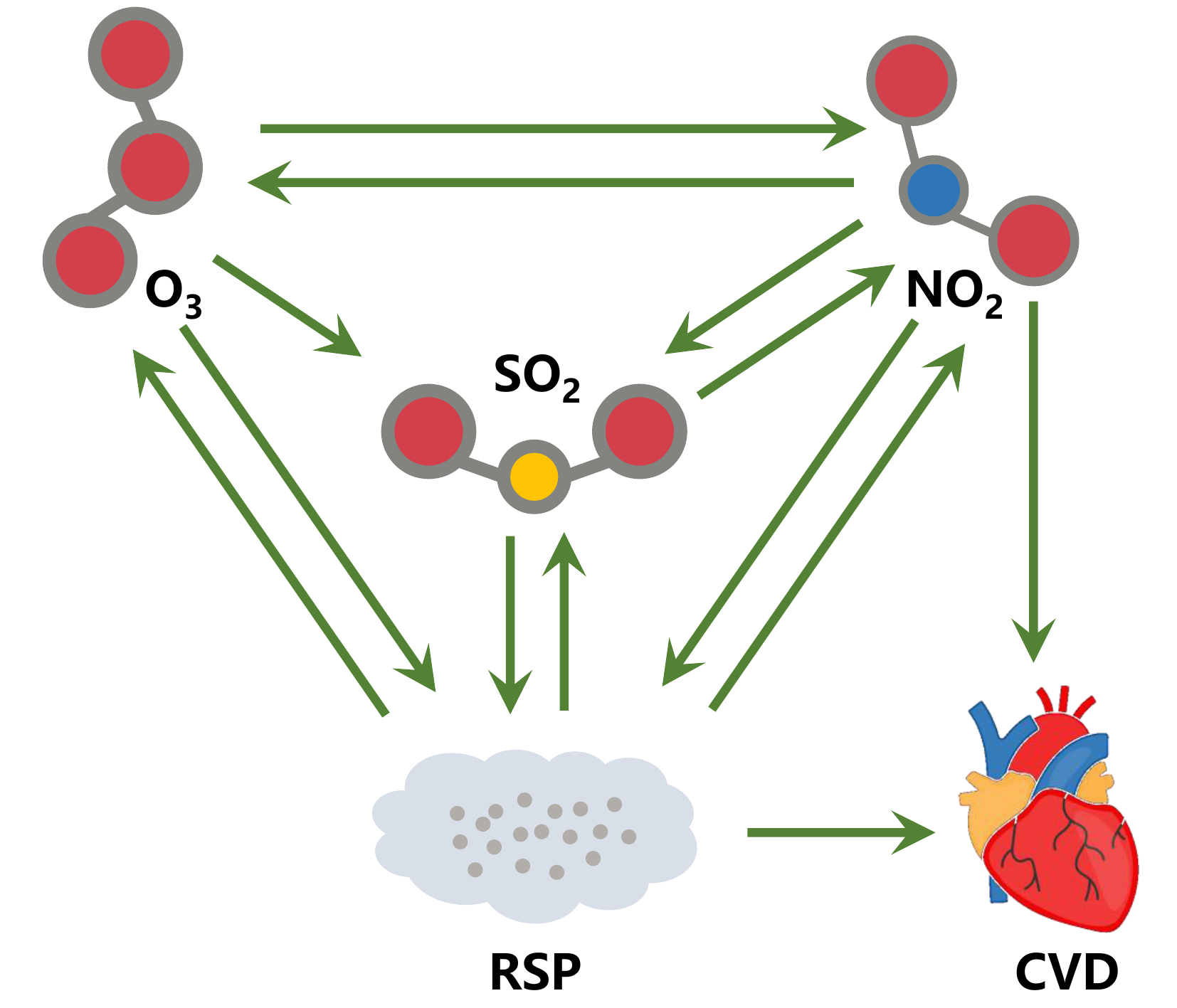
Figure 4. Causal interactions between air pollutants and cardiovascular diseases in Hong Kong.
US County Carbon Emissions and Temperature Dynamics
To examine whether a causal relationship exists between annual mean temperature and total annual CO₂ emissions, we implement the CMC method across counties.
library(tEDM)
carbon = readr::read_csv(system.file("case/carbon.csv.gz",package = "tEDM"))
## Rows: 113627 Columns: 4
## ── Column specification ─────────────────────────────────────────────────────────
## Delimiter: ","
## dbl (4): year, fips, tem, carbon
##
## ℹ Use `spec()` to retrieve the full column specification for this data.
## ℹ Specify the column types or set `show_col_types = FALSE` to quiet this message.
head(carbon)
## # A tibble: 6 × 4
## year fips tem carbon
## <dbl> <dbl> <dbl> <dbl>
## 1 1981 1001 17.4 192607687.
## 2 1982 1001 18.4 187149414.
## 3 1983 1001 16.9 191584445.
## 4 1984 1001 17.8 199157579.
## 5 1985 1001 17.9 205207564.
## 6 1986 1001 18.5 218446030.
carbon_list = dplyr::group_split(carbon, by = fips)
length(carbon_list)
## [1] 3071Using the 100th county as an example, we determine the appropriate embedding dimension by applying the FNN method.
tEDM::fnn(carbon_list[[100]],"carbon",E = 2:10,eps = stats::sd(carbon_list[[100]]$carbon))
## E:1 E:2 E:3 E:4 E:5 E:6 E:7
## 0.29729730 0.02702703 0.00000000 0.00000000 0.00000000 0.00000000 0.00000000
## E:8 E:9
## 0.00000000 0.00000000When E equals 3, the FNN ratio begins to drop to zero; therefore, we select \(E = 3\) as the embedding dimension for the CMC analysis.
res = carbon_list |>
purrr::map_dfr(\(.x) {
g = tEDM::cmc(.x,"tem","carbon",E = 3,k = 20,dist.metric = "L2",progressbar = FALSE)
return(g$xmap)
})
head(res)
## neighbors x_xmap_y_mean x_xmap_y_sig x_xmap_y_lower x_xmap_y_upper
## 1 20 0.17625 1.441152e-06 0.04458194 0.3079181
## 2 20 0.15625 5.526258e-08 0.03225277 0.2802472
## 3 20 0.15625 5.809091e-08 0.03204912 0.2804509
## 4 20 0.20125 3.147621e-05 0.06058040 0.3419196
## 5 20 0.20875 7.165149e-05 0.06498830 0.3525117
## 6 20 0.13125 2.408340e-10 0.01712311 0.2453769
## y_xmap_x_mean y_xmap_x_sig y_xmap_x_lower y_xmap_x_upper
## 1 0.06375 4.154966e-26 0 0.1446512
## 2 0.06250 1.381916e-28 0 0.1398111
## 3 0.06250 4.667439e-26 0 0.1437169
## 4 0.06625 2.180138e-25 0 0.1478975
## 5 0.06875 2.677461e-23 0 0.1537491
## 6 0.05875 1.135327e-30 0 0.1338684
res_carbon = res |>
dplyr::select(neighbors,
carbon_tem = x_xmap_y_mean,
tem_carbon = y_xmap_x_mean) |>
tidyr::pivot_longer(c(carbon_tem, tem_carbon),
names_to = "variable", values_to = "value")
head(res_carbon)
## # A tibble: 6 × 3
## neighbors variable value
## <dbl> <chr> <dbl>
## 1 20 carbon_tem 0.176
## 2 20 tem_carbon 0.0638
## 3 20 carbon_tem 0.156
## 4 20 tem_carbon 0.0625
## 5 20 carbon_tem 0.156
## 6 20 tem_carbon 0.0625
res_carbon$variable = factor(res_carbon$variable,
levels = c("carbon_tem", "tem_carbon"),
labels = c("carbon → tem", "tem → carbon"))
fig_case2 = ggplot2::ggplot(res_carbon,
ggplot2::aes(x = variable, y = value, fill = variable)) +
ggplot2::geom_boxplot() +
ggplot2::theme_bw() +
ggplot2::scale_x_discrete(name = "") +
ggplot2::scale_y_continuous(name = "Causal Strength",
expand = c(0,0),
limits = c(0,0.3),
breaks = seq(0,0.3,by = 0.05)) +
ggplot2::theme(legend.position = "none")
fig_case2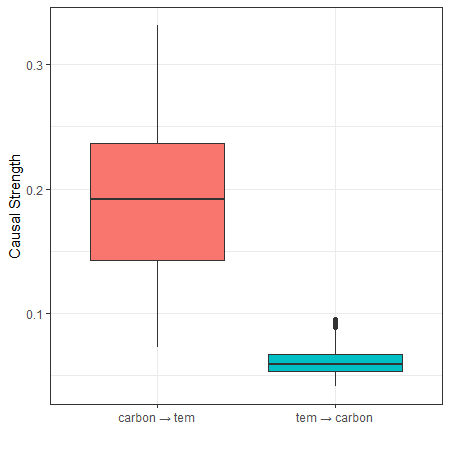
COVID-19 Spread Across Japanese Prefectures
We examine the COVID-19 transmission between Tokyo and other prefectures by applying CCM to identify the underlying causal dynamics of the epidemic spread
library(tEDM)
covid = readr::read_csv(system.file("case/covid.csv",package = "tEDM"))
## Rows: 334 Columns: 47
## ── Column specification ─────────────────────────────────────────────────────────
## Delimiter: ","
## dbl (47): Hokkaido, Aomori, Iwate, Miyagi, Akita, Yamagata, Fukushima, Ibarak...
##
## ℹ Use `spec()` to retrieve the full column specification for this data.
## ℹ Specify the column types or set `show_col_types = FALSE` to quiet this message.
head(covid)
## # A tibble: 6 × 47
## Hokkaido Aomori Iwate Miyagi Akita Yamagata Fukushima Ibaraki Tochigi Gunma
## <dbl> <dbl> <dbl> <dbl> <dbl> <dbl> <dbl> <dbl> <dbl> <dbl>
## 1 0 0 0 0 0 0 0 0 0 0
## 2 0 0 0 0 0 0 0 0 0 0
## 3 0 0 0 0 0 0 0 0 0 0
## 4 0 0 0 0 0 0 0 0 0 0
## 5 0 0 0 0 0 0 0 0 0 0
## 6 0 0 0 0 0 0 0 0 0 0
## # ℹ 37 more variables: Saitama <dbl>, Chiba <dbl>, Tokyo <dbl>, Kanagawa <dbl>,
## # Niigata <dbl>, Toyama <dbl>, Ishikawa <dbl>, Fukui <dbl>, Yamanashi <dbl>,
## # Nagano <dbl>, Gifu <dbl>, Shizuoka <dbl>, Aichi <dbl>, Mie <dbl>,
## # Shiga <dbl>, Kyoto <dbl>, Osaka <dbl>, Hyogo <dbl>, Nara <dbl>,
## # Wakayama <dbl>, Tottori <dbl>, Shimane <dbl>, Okayama <dbl>,
## # Hiroshima <dbl>, Yamaguchi <dbl>, Tokushima <dbl>, Kagawa <dbl>,
## # Ehime <dbl>, Kochi <dbl>, Fukuoka <dbl>, Saga <dbl>, Nagasaki <dbl>, …The data are first differenced:
covid = covid |>
dplyr::mutate(dplyr::across(dplyr::everything(),
\(.x) c(NA,diff(.x))))Using Tokyo’s COVID-19 infection data to test the optimal embedding dimension.
tEDM::fnn(covid,"Tokyo",E = 2:30,eps = stats::sd(covid$Tokyo)/10)
## E:1 E:2 E:3 E:4 E:5 E:6 E:7
## 0.79452055 0.16842105 0.01246106 0.00000000 0.00000000 0.00000000 0.00000000
## E:8 E:9 E:10 E:11 E:12 E:13 E:14
## 0.00000000 0.00000000 0.00000000 0.00000000 0.00000000 0.00000000 0.00000000
## E:15 E:16 E:17 E:18 E:19 E:20 E:21
## 0.00000000 0.00000000 0.00000000 0.00000000 0.00000000 0.00000000 0.00000000
## E:22 E:23 E:24 E:25 E:26 E:27 E:28
## 0.00000000 0.00000000 0.00000000 0.00000000 0.00000000 0.00000000 0.00000000
## E:29
## 0.00000000Since the FNN ratio begins to approach zero when E equals 4, embedding dimensions from 4 onward are evaluated, and the pair of E and k yielding the highest self-prediction accuracy is selected for the CCM procedure.
tEDM::simplex(covid,"Tokyo","Tokyo",E = 4:50,k = 5:60)
## The suggested E and k for variable Tokyo is 4 and 7
res = names(covid)[-match("Tokyo",names(covid))] |>
purrr::map_dfr(\(.l) {
g = tEDM::ccm(covid,"Tokyo",.l,E = 4,k = 7,progressbar = FALSE)
res = dplyr::mutate(g$xmap,x = "Tokyo",y = .l)
return(res)
})
head(res)
## libsizes x_xmap_y_mean x_xmap_y_sig x_xmap_y_lower x_xmap_y_upper
## 1 331 0.70879268 0.000000000 0.65090130 0.7584883
## 2 331 0.15540844 0.004475224 0.04874688 0.2585655
## 3 331 0.61181618 0.000000000 0.53983767 0.6749128
## 4 331 0.51213248 0.000000000 0.42822713 0.5872831
## 5 331 0.02065942 0.707198233 -0.08700953 0.1278513
## 6 331 0.65485497 0.000000000 0.58882105 0.7122050
## y_xmap_x_mean y_xmap_x_sig y_xmap_x_lower y_xmap_x_upper x y
## 1 0.7236820 0.000000e+00 0.6681758 0.7711770 Tokyo Hokkaido
## 2 0.4371497 0.000000e+00 0.3459266 0.5201856 Tokyo Aomori
## 3 0.7574997 0.000000e+00 0.7076344 0.7998568 Tokyo Iwate
## 4 0.7214586 0.000000e+00 0.6655925 0.7692846 Tokyo Miyagi
## 5 0.2884528 8.400987e-08 0.1867672 0.3840232 Tokyo Akita
## 6 0.5021635 0.000000e+00 0.4172045 0.5784216 Tokyo Yamagata
df1 = res |>
dplyr::select(x,y,y_xmap_x_mean,y_xmap_x_sig)|>
purrr::set_names(c("cause","effect","cs","sig"))
df2 = res |>
dplyr::select(y,x,x_xmap_y_mean,x_xmap_y_sig) |>
purrr::set_names(c("cause","effect","cs","sig"))
res_covid = dplyr::bind_rows(df1,df2)|>
dplyr::filter(cause == "Tokyo") |>
dplyr::arrange(dplyr::desc(cs))
head(res_covid,10)
## cause effect cs sig
## 1 Tokyo Osaka 0.9340924 0
## 2 Tokyo Kanagawa 0.9299503 0
## 3 Tokyo Saitama 0.9170512 0
## 4 Tokyo Chiba 0.9148243 0
## 5 Tokyo Hyogo 0.9074071 0
## 6 Tokyo Aichi 0.9053216 0
## 7 Tokyo Ibaraki 0.8765329 0
## 8 Tokyo Nara 0.8746084 0
## 9 Tokyo Shizuoka 0.8659047 0
## 10 Tokyo Kyoto 0.8604876 0Using 0.90 as the threshold (rounded to two decimal
places), we map the causal responses in the spread of COVID-19 from
Tokyo for those with a causal strength greater than
0.90.
res_covid = res_covid |>
dplyr::mutate(cs = round(res_covid$cs,2)) |>
dplyr::filter(cs >= 0.90)
res_covid
## cause effect cs sig
## 1 Tokyo Osaka 0.93 0
## 2 Tokyo Kanagawa 0.93 0
## 3 Tokyo Saitama 0.92 0
## 4 Tokyo Chiba 0.91 0
## 5 Tokyo Hyogo 0.91 0
## 6 Tokyo Aichi 0.91 0
if (!requireNamespace("rnaturalearth")) {
install.packages("rnaturalearth")
}
## Loading required namespace: rnaturalearth
jp = rnaturalearth::ne_states(country = "Japan")
if (!requireNamespace("tidygeocoder")) {
install.packages("tidygeocoder")
}
## Loading required namespace: tidygeocoder
jpp = tibble::tibble(name = c("Tokyo",res_covid$effect)) |>
dplyr::mutate(type = factor(c("source",rep("target",6)),
levels = c("source","target"))) |>
tidygeocoder::geocode(state = name, method = "arcgis",
long = "lon", lat = "lat")
## Passing 7 addresses to the ArcGIS single address geocoder
## Query completed in: 5.4 seconds
fig_case3 = ggplot2::ggplot() +
ggplot2::geom_sf(data = jp, fill = "#ffe7b7", color = "grey", linewidth = 0.45) +
ggplot2::geom_curve(data = jpp[-1,],
ggplot2::aes(x = jpp[1,"lon",drop = TRUE],
y = jpp[1,"lat",drop = TRUE],
xend = lon, yend = lat),
curvature = 0.2,
arrow = ggplot2::arrow(length = ggplot2::unit(0.2, "cm")),
color = "#6eab47", linewidth = 1) +
ggplot2::geom_point(data = jpp,
ggplot2::aes(x = lon, y = lat, color = type),
size = 1.25, show.legend = FALSE) +
ggrepel::geom_text_repel(data = jpp,
ggplot2::aes(label = name, x = lon, y = lat, color = type),
show.legend = FALSE) +
ggplot2::scale_color_manual(values = c(source = "#2c74b7",
target = "#cf574b")) +
ggplot2::coord_sf(xlim = range(jpp$lon) + c(-0.45,0.45),
ylim = range(jpp$lat) + c(-0.75,0.75)) +
ggplot2::labs(x = "", y = "") +
ggplot2::theme_bw() +
ggplot2::theme(panel.background = ggplot2::element_rect(fill = "#9cd1fd", color = NA))
fig_case3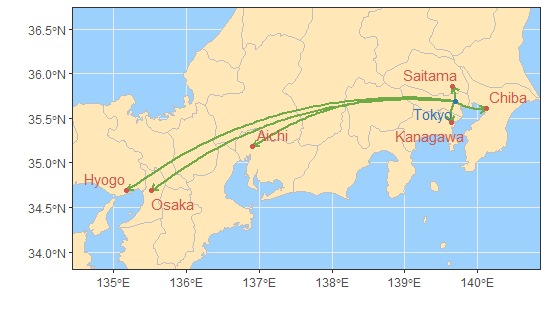
Reference
Sugihara, G., May, R., Ye, H., Hsieh, C., Deyle, E., Fogarty, M., Munch, S., 2012. Detecting Causality in Complex Ecosystems. Science 338, 496–500. https://doi.org/10.1126/science.1227079.
Leng, S., Ma, H., Kurths, J., Lai, Y.-C., Lin, W., Aihara, K., Chen, L., 2020. Partial cross mapping eliminates indirect causal influences. Nature Communications 11. https://doi.org/10.1038/s41467-020-16238-0.
Tao, P., Wang, Q., Shi, J., Hao, X., Liu, X., Min, B., Zhang, Y., Li, C., Cui, H., Chen, L., 2023. Detecting dynamical causality by intersection cardinal concavity. Fundamental Research. https://doi.org/10.1016/j.fmre.2023.01.007.
Clark, A.T., Ye, H., Isbell, F., Deyle, E.R., Cowles, J., Tilman, G.D., Sugihara, G., 2015. Spatial convergent cross mapping to detect causal relationships from short time series. Ecology 96, 1174–1181. https://doi.org/10.1890/14-1479.1.
Gan, T., Succar, R., Macrì, S., Marín, M.R., Porfiri, M., 2025. Causal discovery from city data, where urban scaling meets information theory. Cities 162, 105980. https://doi.org/10.1016/j.cities.2025.105980.